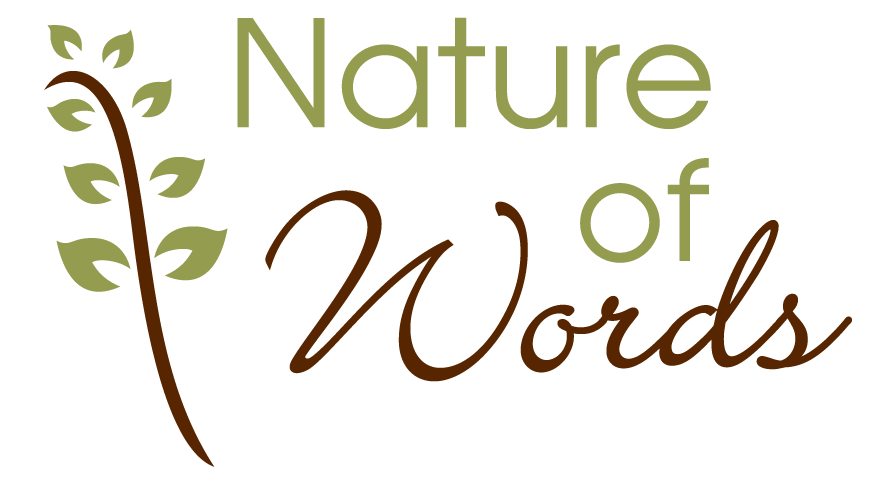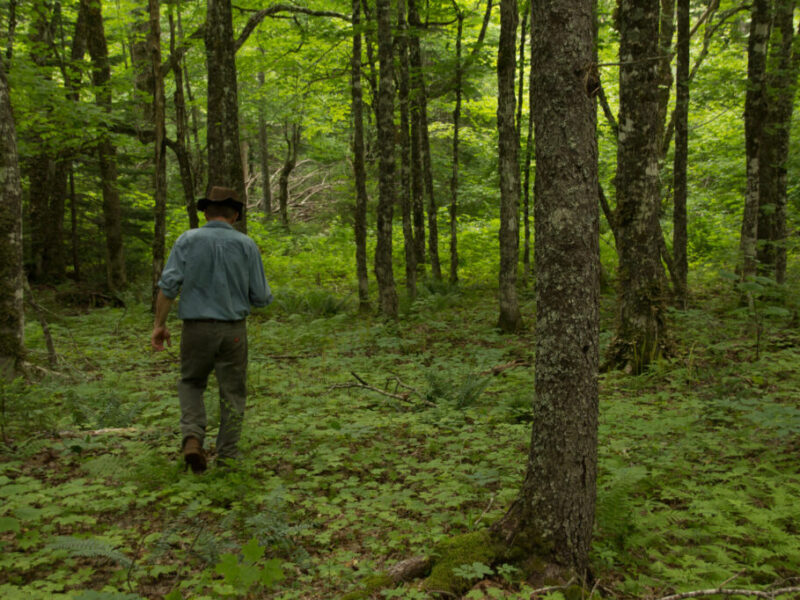
Saving the forest for the trees
Atlantic Business Magazine, Sept/Oct 2023
Fire prevention starts with forest protection; lessons in woodlot management
Mike Spence leads the way through the forest, pointing out landscape features and individual trees, mushrooms and woodland flowers. Sunlight filters through the leafy canopy, moss cushions the ground, water tumbles over roots and stones in a nearby brook. We spot tracks from a doe and fawn, a moose and bear.
“We’re trying to maintain the forest that’s been here for 200 years,” he said. “We have maple, yellow and white birch, spruce, oak, hornbeam, ironwood and ash…”
Spence knows every foot of his 900-acre property as well as he knows his own capabilities. The shaded softwood stands, the mixed hardwoods, the places that hold snow in winter, the clean water springs, the bogs and small brooks, the beaver pond.
This as close to an original Wabanaki-Acadian forest as you might find these days, but the Baie Verte, N.B. woodlot owner is starting to see worrisome change. He can’t work in the woods as late in spring as he once did because frost leaves the ground earlier. Temperatures are rising. Water levels are dropping. Bogs are shrinking. He wonders what the future holds.
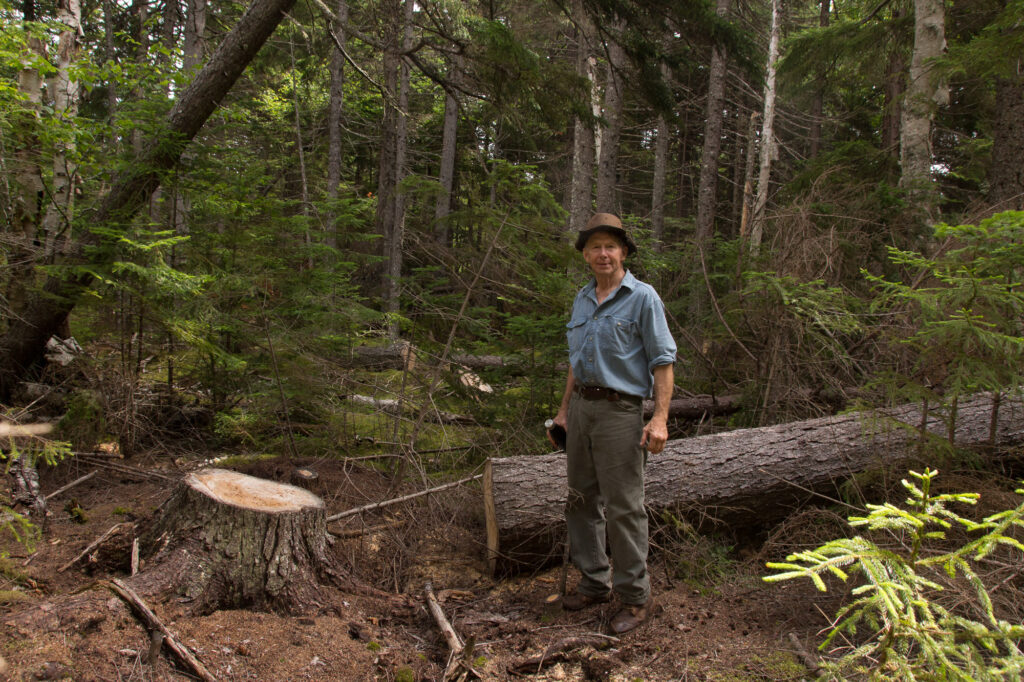
Baie Verte, NB woodlot owner, Mike Spence, stands beside a red spruce damaged during Hurricane Fiona.
He navigates to the pale stump of a red spruce almost two feet across. A few feet away, its trunk disappears into a tangle of branches. “This tree is about 200-years-old. I’d never have cut it, but the top came down in Fiona.” He pauses. Removes his hat, swipes his hand through his hair before replacing it. Scans the length of the trunk.
“I’ll save this for something special. We’ll not see trees like this again.”
The hurricane that wreaked so much damage across the Maritimes last September funneled through like a tornado, toppling 20-30 of the oldest, tallest trees, but leaving adjacent areas unscathed. He’d rather decide which trees to cut—choosing the imperfect, weak, damaged or over-mature, all the while being watchful not to disturb nests or dens—but nature had other ideas.
He admits logging is hard for a tree-hugger, but tries for optimism. It’s opened up the canopy. It’ll leave room for something else to grow. Salvaging the blowdowns and damaged trees will provide a ready supply of timber in the coming months.
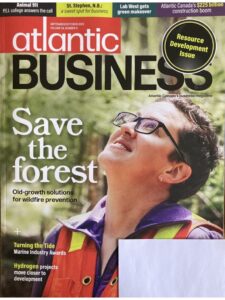 He knows climate change is upon us and Fiona was a portent of more and bigger storms to come, but the wildfires fueled by early drought and high winds that devastated Maritime forests and neighbourhoods before the hardwoods had leafed out this spring are a different demon. As the climate continues to heat, he expects the tragedy will repeat.
He knows climate change is upon us and Fiona was a portent of more and bigger storms to come, but the wildfires fueled by early drought and high winds that devastated Maritime forests and neighbourhoods before the hardwoods had leafed out this spring are a different demon. As the climate continues to heat, he expects the tragedy will repeat.
For decades, he’s managed his land well—it now offers the best resilience against the impacts of climate change, and his stands of multi-aged hardwoods with their leafy understory create a natural barrier to fire—but he can only do so much.
“I can’t control what goes on outside. We’ve had clear cuts all around us. Ours is the only block of woodland that hasn’t been cut into,” he said. “How do you protect against that?”
***
The key ingredients for wildfire are fuel, ignition, and weather. Climate change is predicted to worsen all three so any conversation on fire prevention must also include climate adaptation.
“The more simplified your forest with homogenous species and structure, the easier it is for fire to spread,” says Megan de Graaf, a forest ecologist with Community Forests International (CFI). The Sackville, NB charity works with individuals, organizations, and communities to restore degraded lands, protect forest ecosystems, and support climate adaptation.
Historically, fires have not been a major issue in the Maritimes due to the damp coastal weather and natural resiliency of the now endangered Wabanaki-Acadian forest. Natural blazes, such as those caused by lightning strike, were mostly short-lived, and served a critical purpose by killing off pests and disease, clearing dead trees, scrub and undergrowth, nourishing the soil, and allowing for new growth. Some trees, such as jack pine, need intense heat to split the hard shell of their cones, allowing germination.
The 32 species of trees growing within this temperate zone made it more fire-resistant than the conifer-dominated boreal forest ranging in the north from Newfoundland to the Yukon. But only one percent of intact old growth remains.
Once the forest was seen as a resource to be protected, humans became good at suppressing fires, resulting in older stands of trees and build-up of debris. Time passed, demand for wood increased, industry clearcut the mixed forest, then pursued silviculture practices favouring the softwood species needed for pulp, thereby changing the forest cover, age and composition.
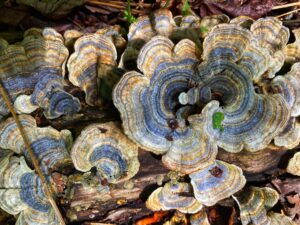 De Graaf contrasts the structurally-diverse and complex natural forest of pre-colonial days, when humus was multi-layered and deep, and tree stands varied in age, size, height and diversity, with today’s industrially-managed forests with disrupted, dry soil, even-aged, single-species plantations and clear cuts. These softwoods, with their flammable pitch and proliferation of dried needles, not only fuel fire more easily than leafed out hardwoods, but will prove less climate resilient over time.
De Graaf contrasts the structurally-diverse and complex natural forest of pre-colonial days, when humus was multi-layered and deep, and tree stands varied in age, size, height and diversity, with today’s industrially-managed forests with disrupted, dry soil, even-aged, single-species plantations and clear cuts. These softwoods, with their flammable pitch and proliferation of dried needles, not only fuel fire more easily than leafed out hardwoods, but will prove less climate resilient over time.
Naturally-occurring species such as balsam fir, black spruce, white birch are also less likely to survive the warming temperatures creating pockets of dead and dying trees.
Humans pose another risk. Logging has opened up more roads into the forest, thus increasing access for hunting and recreation. The motorized vehicles traveling the woods is unprecedented.
“About 95% of forest fires are human-caused,” says de Graaf. “We have this changing pattern, with more drought, more wild weather, more blowdowns, then someone acts as a direct source of fire in the forest.”
Add die-out from a huge pest infestation, or wind event like Fiona, and this creates more fuel.
“Tying all these together is climate change,” says de Graaf. “The interplay of all these parts means we’ve set ourselves up with a vulnerable forest condition. We’ve decreased the resiliency of the forest. So, any management that we do to increase the forest’s climate resiliency and its capacity to sequester and store carbon becomes a win for fire, wind, mitigation of climate, for bio-diversity and social values.”
A 2017 study, published in the Proceedings of the National Academy of Sciences, demonstrated that nature-based climate solutions could provide up to 37 percent of the emission reductions needed by 2030 to keep global temperature increases under 2 degrees Celsius. And forest-based solutions have the highest mitigation potential, while also contributing to cleaner air, enhanced biodiversity, improved water filtration and soil quality.[1]
CFI estimates there are about 90,000 family woodlot owners in Atlantic Canada, making up 40 percent of forested land. This leaves private ownership with an important role to play in forest protection. Based on de Graaf’s experience, woodlot owners, by and large, care about their forests, and clear cuts are generally undertaken out of necessity for income.
She wishes there were more options to reward landowners for growing trees, however programs such as carbon offsets are complex and not advancing at the pace needed to address climate issues. But there are actions that can be done now to prepare for a carbon market later.
For landowners who want to manage for climate adaptation as well as income, she recommends minimal harvesting, encouraging climate-resistant species and improving the complexity of the forest, which will protect against fire and maximize carbon pulled from the atmosphere.
“The more private woodlot owners who choose to manage their forests for climate benefit and resiliency, the better for everyone. This is one of the best tools at our disposal, a nature-based climate solution.”
***
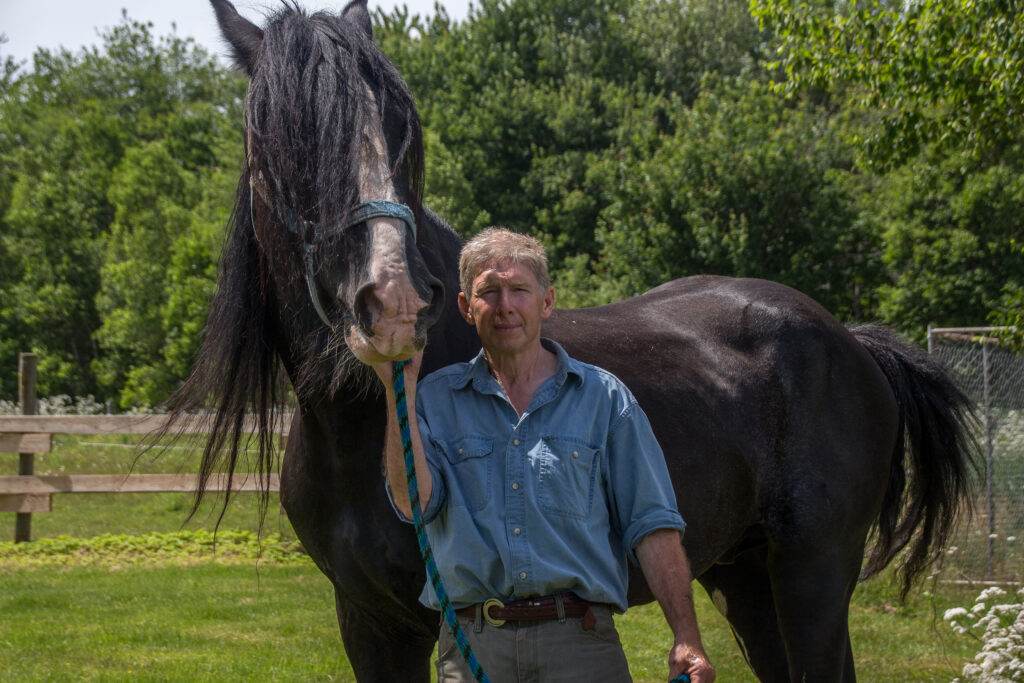
Mike Spence with Domino, the Shire horse he keeps for logging.
A mobile farrier by trade, Spence also cuts, custom-saws and kiln-dries specialty wood from his woodlot. His dried hardwood has ended up as mantles, furniture, musical instruments, canoe paddles. His wood is FSC certified, and stamped/graded for house construction.
He’s gradually removing the balsam fir, opening up pockets for the more climate resilient red oak, red maple, yellow birch, and trying to re-establish the hemlock and white pine removed in the 1800s. He’s one of the few who plant hardwoods.
His style of woodlot management is actually more generationally-inherited than climate-inspired. He was only six when his grandfather, Vincent Goodwin, asked if he’d rather go to Sunday School, or with him to the woods. In the coming years, the two spent countless hours together. Goodwin worked his woodlot with oxen or horses and taught his grandson everything he knew.
“He always pointed out the brooks and salamanders. Everything that lived above and below the ground. The life you could see and what you couldn’t see,” says Spence. “By the time I was 12, I was doing patch cuts of old growth for a small logging company. Every night, when I came home, he’d ask me about my day, give advice.”
At 15, Spence bought his first 60-acre woodlot with the money he’d earned. Then, he sold his half of the snowmobile they shared to his brother, and bought a Morgan quarterhorse. With his own woodlot, and a horse to work it, he’d established a clear direction.
By his twenties, after discovering he could gain more value and return from a tree that he cut, sawed and sold himself, he chose self-employment. He built himself a mortise and tenon spruce log home on land his grandfather gave him. One room in particular overlooks wide fields, rich forest, and in the distance, the shimmering waters of Northumberland Strait.
“When he couldn’t walk the forest any more, I’d bring Grandfather here and he’d sit for hours in this room. I bought a video camera to record what I was doing in the woods. Each night, we’d watch that tape together, so he could see what I was doing.” Eventually, his grandfather’s woodlot became his.
Today, Spence keeps a Shire for logging, and by holding true to the values Goodwin taught him, has earned steady income from his land for more than forty-five years, and still has a natural forest as healthy as when he first entered it as a boy. He walks a piece of woods for weeks before deciding what to cut.
“It takes a lot of thought and skill to cut logs with a horse. You plan your roads, which trees to cut, and how the horse will walk through with a log on. You end up with a pile of logs in the dooryard, yet you haven’t disturbed a thing in the forest.”
***
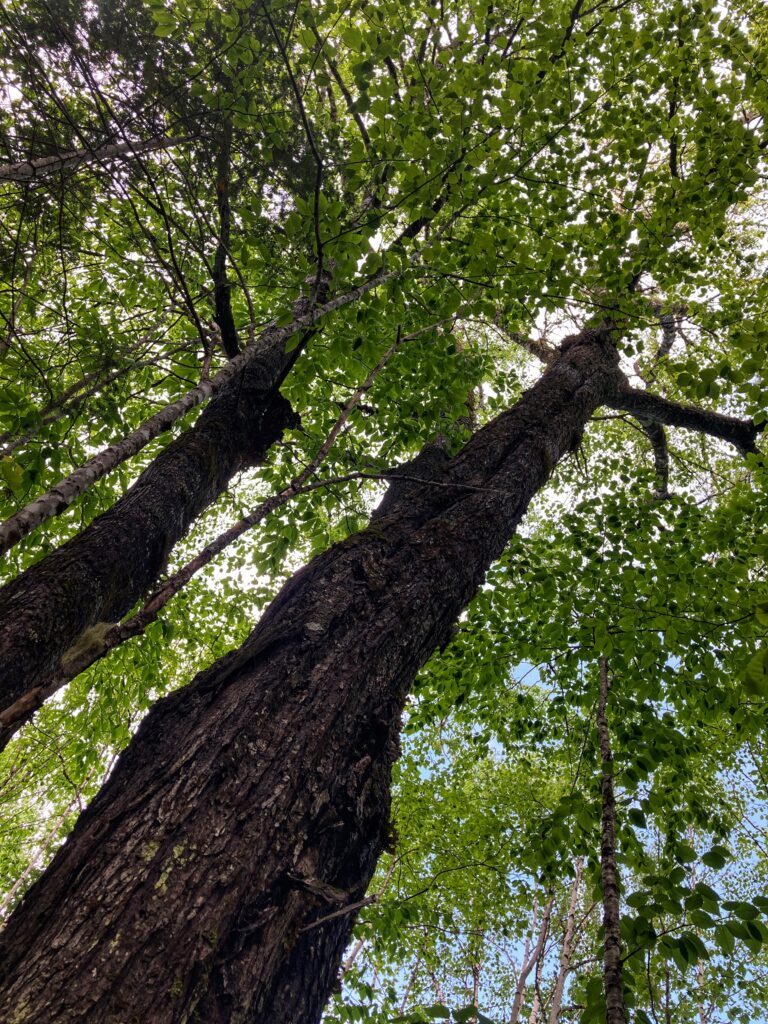 Like Spence, Dr. Anthony Taylor, Associate Professor of Forest Management with the University of New Brunswick, has a generational attachment to trees. His early years on the family woodlot inspired an interest in weather impacts, and he now studies how humans, natural disturbances and climate change affect the structure and function of the forest.
Like Spence, Dr. Anthony Taylor, Associate Professor of Forest Management with the University of New Brunswick, has a generational attachment to trees. His early years on the family woodlot inspired an interest in weather impacts, and he now studies how humans, natural disturbances and climate change affect the structure and function of the forest.
He co-authored recent research, with data gathered from across the country, showing that the more diverse the forest, the greater its capacity to sequester carbon, and much of that storage is in the soil. So, when large areas of trees are removed, the soil’s carbon storage capacity is compromised.
“The fate of the carbon depends on what you do with that wood, but when you take away the forest canopy, you’ve less input going into the soil. The other major thing is that you’ve increased light and warmth, increasing decomposition, which results in greater carbon loss until the canopy starts to develop.”
Taylor grew up in Nova Scotia’s Muskodoboit Valley, the fifth generation to work the family’s woodlands. With his siblings, he helps manage Taylor Lumber Co. Ltd. He’s aware of the irony and tries to find the balance between the environment he studies, and the business he inherited.
“Right now, softwood is at the heart of what we do, but other values must be taken into account too,” he says.
Some woodlot owners, fearing future losses from fire or windstorms, may be tempted to clearcut for immediate gain, but Taylor advises against such short-term thinking. Forests have a vital role to play in the coming years and most fires are not naturally-caused.
“If you’re concerned about fire as an individual, or society, then we need to practice safety in the forest.” He wishes there was more public awareness and education on fire safety and prevention, and the pressing issues of climate.
“It’s always a battle with a profit-making business, but if you recognize the forest you rely on needs to be sustainably managed, clearing or converting the forest to a softwood plantation isn’t an option.”
In his experience, many private owners are unaware what grows on their woodlots. “It’s important to get a good sense of your forest. You don’t know what to do with it until you know what you have,” says Taylor.
To this end—whether the objectives are fire prevention, improving climate resilience and eco-system health, generating income, or a combination—a forest management plan developed by a professional forester can provide a path forward. The forester conducts a detailed inventory of species, soil, and landforms, then produces a plan to help the landowner achieve their specific goals. It differs by province, but woodlot owner associations, marketing boards and wood co-ops offer these services and resources, sometimes free with membership, or with subsidies to offset costs.
He believes there’s no reason that forest resiliency and income can’t co-exist. A woodlot owner can still grow spruce and fir for the industry, but do less of it, and ensure they maintain a mix of species. His family’s plantations account for less than 5% of their holdings, but are limited in size and surrounded by mixed stands. He recommends selection harvests where possible, but if clearcutting seems necessary for a particular stand, consider observing for a few years what regenerates naturally.
“If you think in the long term and the greater role of the forest for the world and our society, then you realize things like diversity matter. The forest provides so many goods and services, filtration and purification of water, carbon storage, wildlife habitat, cultural, recreation and economic values. Striking that balance is at the heart of forest management for the landowner or steward of the land.”
And for the woodlot owner who thinks their small piece of woodland won’t make any difference in the big picture, Megan de Graaf says this: “I think that every corner of our province, big and small, has a role to play in mitigating the climate crisis. The landscape has been so degraded and has been fragmented in so many ways that even the smallest forest property has something to contribute towards the restoration of our ecosystem.”
***
Back in Baie Verte, Mike Spence knows his lifestyle isn’t for everyone, but says he gains so much more than economic value from the forest. He hopes that more people learn to appreciate the potential and gifts of the trees, and not just as a fire break or carbon sink.
“If I can get to the woods after shoeing all day, it calms me down. The smells, the sounds, the feel of the earth…doing work with your hands. You walk with your bare feet and it brings you back where you should be.”
